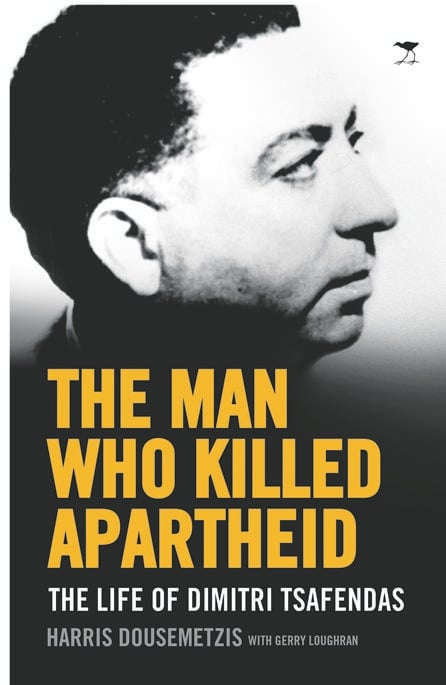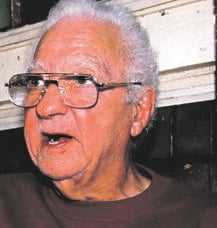
The man who was famously known for assassinating former prime minister Hendrik Verwoerd was declared a madman by the state.
Harris Dousemetzis, author of a recently released book on the subject, explained to political editor Rapule Tabane why history is wrong about Dimitri Tsafendas
For me, one of the most fascinating aspects of this book on former prime minister Hendrik Verwoerd’s killer Dimitri Tsafendas is that the author only heard about him after his death.
Yet Harris Dousemetzis, a British academic with no previous connection to South Africa, took nine years, with no financial backing, to translate copious documents from Portuguese and Afrikaans, and write this compelling 400-page book on Tsafendas.
But he did not stop there.
He also wrote a 900 000-word petition to the South African government to rectify the history books about Tsafendas, who was declared a state patient and was kept in prison and a mental institution until he died in 1999.
The Man Who Killed Apartheid: The Life of Dimitri Tsafendas by Harris Dousemetzis with Gerry Loughran
Jacana Media
R265 at takealot.com
Dousemetzis worked on the book while busy with his PhD on former US president Jimmy Carter.
But the passion he developed for Tsafendas, who was widely dismissed as a mental case, is gripping.
For him it is a matter of correcting a historical injustice that Tsafendas died a lonely death with no family around him and, especially, with no acknowledgement that he had been a fighter who had tried to end apartheid.
Even more painfully, Tsafendas could have been released and enjoyed his last days in freedom but, at a time when the new government was prepared to release him in 1994, there was no one prepared to accommodate him and stay with him.
I asked Dousemetzis what he wanted to achieve with this project:
“I also want to offer him some dignity because he has been completely misportrayed. He has been slandered so much. It is for his reputation that I am doing this, although he did not care for his reputation,” he points out.
During my interview with Dousemetzis, I challenge him by asking him why South Africans in 2018 should care when many do not even remember who Tsafendas was.
We have moved on. We have new and particular challenges now; does it really help us to be revisiting the history of the apartheid era?
“They don’t need to care about him,” he asserts boldly.
“The issue is not whether or not they care about him. The aim is to correct a historical record. Those who know him will speak in correct terms. People must know the truth. This is not about making Tsafendas known or glorifying him.
Dousemetzis said he first learnt of Tsafendas after reading his obituary, which piqued his interest.
He then met a whole list of people who had known Tsafendas at different stages of his life.
What was common among the various individuals was that they all insisted that Tsafendas was a sane man.
After the assassination of Verwoerd, they refused to believe the official government line that he was a madman who had a tapeworm that made him do things.
Dousemetzis says that, in the first police interrogation that happened after the assassination, Tsafendas told police that he had killed “the architect of apartheid” because he was disgusted with his racial policies.
Tsafendas committed the crime on September 6 1966 and on September 11 he made his first statement to the police.
“He said he hoped that a change of policy would happen with the death of Verwoerd. He also said Verwoerd was a dictator. He believed he was not a true representative of all South Africans, and Tsafendas wanted a government that would represent all South Africans.”
Dousemetzis has a copy of the statement.
“It is 11 pages long and he never said anything that suggests that he might have been insane. He does not mention tapeworm anywhere and speaks coherently.”
On September 20 Tsafendas made a second statement to the police. He described in detail how he killed Verwoerd and what happened before the assassination.
Dousemetzis said he took both statements and gave them to the top forensic psychiatrists in the world to examine and decide whether they matched the police description of a person “who was talking in a disjointed manner, who could not follow a conversation after 15 minutes and who could not function at a reasonable level”.
“I asked whether it was possible that for 46 years there was not one person who had noticed all these qualities except for the police.”
He also asked if there were any signs of schizophrenia in his statements and they all said no.
Dousemetzis believes that between September 20 and 26 something happened. On September 26, when he was seen by his lawyers, Tsafendas mentioned the tapeworm for the first time.
He had told priests that he could not take the torture anymore. And he believed that he was going to be killed.
“Sometime after September 20 he decided he had had enough of the torture. He was afraid of having an undignified death. He was not afraid to die but did not want to have an undignified death.”
Dousemetzis is convinced that the tapeworm story is a myth.
“It is as much of a myth as that anti-apartheid activist Ahmed Timol committed suicide or that Black Consciousness leader Steve Biko died from natural causes.”
Immediately after he was arrested, police interviewed 200 people who knew him, but not one of them said anything about a tapeworm or Tsafendas having a mental condition.
Long before he killed Verwoerd, Tsafendas had once confided to a friend, Patrick O’Ryan, that he pretended to be mad in order to avoid serving in the army in Mozambique.
When O’Ryan asked him how he did it, he said he had told them he had a tapeworm.
Tsafendas had himself internalised the tapeworm story after picking it up from a friend in the US, Tom Tuff, who he met in a hospital there.
Tuff had been claiming that he had a tapeworm since he was a child. This enabled him to receive extra food from the hospital, claiming that the tapeworm was eating his food.
Tsafendas observed him every day and was convinced that Tuff was lying, but was doing it to avoid serving in the US army. He was faking mental illness, but this strategy impressed Tsafendas.
Dousemetzis believes Tsafendas was a revolutionary.
“Tsafendas was deeply inspired by Frantz Fanon who had said violence against the colonialists was not only justifiable but necessary.
“He believed that violence was necessary to deal with racism.”
Beyond writing this very interesting and well-researched book, Dousemetzis also prepared a lengthy document making a case for the reclassification of Tsafendas as sane.
“I thought the best way would be to give evidence to the relevant authorities, such as the minister of justice.”
Dousemetzis approached several South African jurists to help him in this regard.
All are renowned legal minds with a history of fighting for human rights and include George Bizos, Jody Kollapen, Chris Govender, John Dugard, Albie Sachs and Dumisa Ntsebeza.
In 1994, Kollapen, when he was still with Lawyers for Human Rights, had gone to extreme lengths to get Tsafendas released.
This was frustrated by some of the family members being unavailable for Tsafendas to live with if he were released.
Dousemetzis worked with Kollapen to draft the letter sent to the justice minister.
In it they asked the minister to look again at the Tsafendas matter in light of new evidence, and re-evaluate the case.
They also wanted the minister to make a public announcement accepting the report and confirm that Tsafendas was politically motivated and not insane when he assassinated Verwoerd.
And they wanted a commitment that history books would then teach the correct history of Tsafendas.
“I am very confident that the minister will come to the same conclusion,” Dousemetzis said.
Part of the submission this year included 12 000 pages of archives, newspaper articles and other evidence.
 |
| ||||||||||||||
| |||||||||||||||




 Publications
Publications
 Partners
Partners











